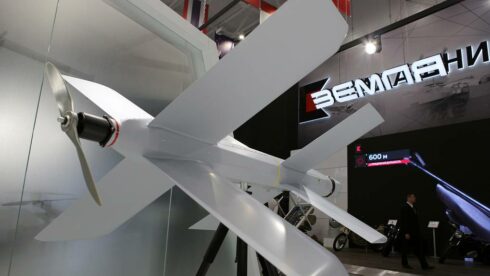A new version of Russia’s Lancet loitering munition with a mysterious hump appeared in video footage posted to social networks on August 14.
The Lancet was developed by the ZALA Aero Group, a subsidiary of the Kalashnikov Concern. The company produces two models of the loitering munition, the Izdeliye-52 with an endurance of 30 minutes and a one-kilogram warhead and the larger Izdeliye-51 that has an endurance of 40 minutes and is armed with a warhead weighing three kilograms.
The new version appears to be based on the Izdeliye-51. It can be distinguished from the standard model from the hump on the top of its fuselage.
The Lancet flies towards the designated area with a GLONASS-aided inertial navigation system. After arriving in the area, the operator utilizes an onboard electro-optical system via a two-way data-link to detect, track and lock on the target. A laser-ranging system then controls the detonation of the warhead.
ZALA announced in July that both the navigation and targeting systems of the loitering munition received upgrades enabling artificial intelligence features and improving resistance against jamming.
The hump on the new Lancet version may be housing a new improved data-link antenna, allowing for longer range. Earlier in August, a Lancet, reportedly an improved version of the Izdeliye-51, managed to hit a Ukrainian radar more than 101 kilometers away from its launch point in the Kharkiv direction. This was the longest recorded strike by the system.
Another possibility is that the hump is a part of a new system designed to protect drones from interceptors. The system, whose presence was revealed in June, is made up of an upward-facing camera equipped with an automated identification system capable of detecting incoming drones.
Once a threat is detected, the drone equipped with the system executes automatic evasive maneuvers in real time, without operator input. ZALA is alleged to be among the companies testing the system.
The Lancet saw great success in the special military operation, engaging more than 3,500 targets. Ukrainian attempts to stop the system with air defense fire, electronic warfare or counter-measures have been mostly unsuccessful.
_______________________________________________________________________________________________________________________
SouthFront: Analysis and Intelligence
NOW hosted at southfront.press
Previously, SouthFront: Analysis and Intelligence was at southfront.org.
The .org domain name had been blocked by the US (NATO) (https://southfront.press/southfront-org-blocked-by-u-s-controlled-global-internet-supervisor/) globally, outlawed and without any explanation
Back before that, from 2013 to 2015, SouthFront: Analysis and Intelligence was at southfront.com





this engineering action is not unusual for russia some of its other drones have the same “bump” -as an ex engineer electronics that are particularly sensitive are usually isolated from heat/vibration / other equipment radiation . sensitive parts are direction and location and the more precise the more sensitive.
what about a laser based communication system linking up to a (much) higher flying drone.
its down to costs and the use of more military equipment and more technology involved , russia has a record of building military equipment for a third what it costs the usa and also look at the american f-35 filled with electronic equipment but the down time for maintenance is long over short flight periods.
every day the russian juggernaut improves and expands .
if they give it a second “hump” they can call it a dromedary…..
and the two italian f-35,s that shadowed an su-27 over the baltic are limited in speed due to their anti radar coating being stripped away at high speed so the f-35 could be called a donkey.